Adrian Collins's Blog, page 34
December 13, 2024
Path of Exile 2 Early Access: First Impressions
The long awaited follow up to the popular ARPG, Path of Exile, entered live Early Access on Friday 6th December. Path of Exile 2 hit the top of Twitch with over 1.1 million viewers at launch, and that’s before anyone had even gotten into the game. Since the big reveal stream on 21st November, hype had been building for the launch with developers at Grinding Gear Games expecting around a million players on launch. Despite some last-minute server and database patching that caused delays, some players estimated a million on Asia’s servers alone. On Steam, Path of Exile 2 hit a peak concurrent player count of 578,569, sending it straight into the Top 5 Most Played Games on the platform, and entering at 15th place for all-time highest concurrent player numbers.
 The cinematics and trailers released so far depict a visually and thematically dark game, in keeping with the history of the series, with scenes of torture, tentacles and bloody experiments. Not least, someone being sliced in half vertically, Thir13en Ghosts-style. Path of Exile 2’s background describes a time of peace across Wraeclast in the interim period from the first game, which is now being threatened by tyranny and a lust for power. There are those in the world who seek to harness the power held in a Seed of Corruption, and it is here that a new exile enters to try and overcome evil and put the Corruption back in its box. Or, in this case, a ball.
The cinematics and trailers released so far depict a visually and thematically dark game, in keeping with the history of the series, with scenes of torture, tentacles and bloody experiments. Not least, someone being sliced in half vertically, Thir13en Ghosts-style. Path of Exile 2’s background describes a time of peace across Wraeclast in the interim period from the first game, which is now being threatened by tyranny and a lust for power. There are those in the world who seek to harness the power held in a Seed of Corruption, and it is here that a new exile enters to try and overcome evil and put the Corruption back in its box. Or, in this case, a ball.
As Path of Exile 2 is in Early Access, this is not the full release, not the full game. For now, there are only six (6) out of twelve (12) character classes available, each with only two (2) out of three (3) ascendancies (think class specialisations) and we only have access to the first three of six campaign acts. However, GGG focussed on having end game activities ready for Early Access, so once you’ve reached a high enough level you can move into mapping. Some classes will look familiar, such as the Ranger, or the Witch, however there are new classes to investigate too. The Sorceress feels like an elemental-focussed split from the original game’s Witch but with some interesting options at Ascendancy (a Chronomancer who can control time, for example). The Mercenary is also proving very popular, and looks reminiscent of Victor Vran, with his crossbow skills feeling much more FPS-like than anything before in PoE.
Some jankiness can be expected in any Early Access game, especially one of this size (a cool 86GB download awaits you). The team at GGG handled the delays on launch day admirably and the game was playable within a couple of hours (much better than the delays Diablo 3 suffered on full release). If you’re a veteran Path of Exile player, you’re going to notice a difference in play style. PoE2 is a much slower pace and feels much more soulslike that the original game. Yes, power creep was becoming an unwieldy beast in Path of Exile, but a lot of feedback coming in after launch weekend is that PoE2 is difficult and rewards are minimal. From my own experience, I have to agree. I’m not a soulslike fan; I don’t find dying 15 times to an act boss rewarding in and of itself, and I have had to get up and walk away for a few hours at least three times already. And, I’ve only just completed Act 1.
I’m not a top tier player by any means. I have rarely made it to ‘uber bosses’ in Path of Exile but can usually get as far as completing the Atlas, sustaining red maps and the occasional ‘pinnacle boss’ with some help. I am, in PoE terms, a slightly above average skill level. Of course, all the elite streamers have completed the campaign and are already into the end game, but a lot of people are going to be grinding through the campaign for days to come. I have played for 16 hours and died 57 times already. By comparison, in the Settlers of Kalguur league for Path of Exile, I didn’t die at all during the campaign and only started having trouble at the high end of maps. Power creep needed addressing, but this might have gone too far the other way.
Visually, Path of Exile 2 is beautiful. My machine is struggling at some points when there’s a lot going on but hasn’t quite gone full toaster-mode. If you’ve not upgraded your graphics card for a few years, you may have some issues. Thematically, the story is suitably grimdark and all the attention to detail in the worldbuilding really shows through. There’s variety in the interactions with NPCs based on which class you choose, and variety in environments to fit the different cultures of the game. Overall, this Early Access release is giving me a lot of hope and excitement for the full release. I know there’ll be patches and balancing as the days, weeks and months progress so GGG can get it right. If you’re a fan of the ARPG genre, Path of Exile is an absolute staple and 2 will surely add a great deal of value to the canon.
Path of Exile 2’s Early Access is partially-closed, insofar that you need a key. If you’ve spent more than $480 on supporter packs and microtransactions in the first game, you’ll find a key waiting for you on the website. Alternatively, you can buy a key for $30. If you’d prefer to stick 100% free-to-play, Path of Exile continues in its own right and a new league is estimated to be coming towards the end of February 2025. Upon full release, PoE2 will also be completely free-to-play, but this could be another 6 to 12 months, depending on how development goes. It’s available for PS5, Xbox X/S Series and on PC via Steam, Epic Games, or the standalone client.
The post Path of Exile 2 Early Access: First Impressions appeared first on Grimdark Magazine.
December 12, 2024
REVIEW: Conan the Barbarian: Battle of the Black Stone #3
Conan the Barbarian: Battle of the Black Stone #3 begins with the Heroes of Man reeling from the loss of two of their own. The giant, many-armed creature now known as the Beast of the Black Stone has demonstrated that it’s capable of pursuing and killing its victims across time and space, and that there is no safe refuge for Conan and the other gathered champions.
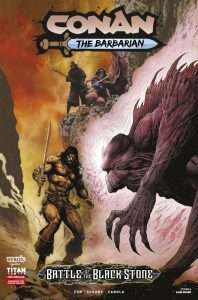 The Pictish scout Brissa guides them through the wilderness using a fragment of the Black Stone that harbors a remnant of the immolated Texan author James Allison’s soul. Thrown together by circumstance, the six survivors react differently to their task and their companions. Conan and Brissa relish their unexpected reunion. Dour Puritan adventurer Solomon Kane and hot-tempered swordswoman Dark Agnes de Chastillon—both displaced from the 16th century—are skeptical of their companions but face the struggle against the Beast with grim resolve. Conrad and Kirowan remain fascinated by the occult implications of their plight. A disastrous encounter with another shard of the Black Stone leads to an unplanned confrontation with the Beast, however.
The Pictish scout Brissa guides them through the wilderness using a fragment of the Black Stone that harbors a remnant of the immolated Texan author James Allison’s soul. Thrown together by circumstance, the six survivors react differently to their task and their companions. Conan and Brissa relish their unexpected reunion. Dour Puritan adventurer Solomon Kane and hot-tempered swordswoman Dark Agnes de Chastillon—both displaced from the 16th century—are skeptical of their companions but face the struggle against the Beast with grim resolve. Conrad and Kirowan remain fascinated by the occult implications of their plight. A disastrous encounter with another shard of the Black Stone leads to an unplanned confrontation with the Beast, however.
From a narrative and characterization standpoint, Conan the Barbarian: Battle of the Black Stone #3 is a mixed bag. The interactions and dialogue between Conan and Brissa are well done. Years have passed since Brissa’s presumed death at the climax of Conan the Barbarian #4 (with her supernatural escape revealed in The Savage Sword of Conan #4); the two were intimate when they traveled together, but Conan is older now, battle-scarred and experienced. This story takes place after Conan has loved and lost his pirate queen Bêlit, perhaps the most impactful relationship in his life, but thrown together with Brissa again he rediscovers his attraction for the Pict. While apparently little time has passed for Brissa, for her part she finds the more mature Conan to still be “burning bright,” subtly echoing Atali’s appraisal of the barbarian’s vitality in the Frozen Faith story arc (Conan the Barbarian #16). Their scene together is a nice bit of character work in a largely rushed-feeling miniseries.
Unfortunately, the other characters in the story continue to be mishandled or neglected. While the bonding scene between Solomon Kane and Dark Agnes is entertaining, both characters’ subsequent individual portrayals either feel inauthentic or fail to communicate their appeal as original author Robert E. Howard created them. Last issue Solomon Kane attacked Conan without any real justification (apart from to provide an eye-catching cover illustration), and this issue he randomly and inexplicably accuses Brissa of responsibility for a companion’s death. Dark Agnes fares even more poorly. After being mostly sidelined for two issues she finally gets some screentime, only to make a bizarrely rash decision that has catastrophic consequences for her and her companions.
Jim Zub began the Battle of the Black Stone miniseries with eight characters and issue #3 concludes with—to the best of the reader’s knowledge—three surviving heroes. The intent seems to be to create a high-stakes atmosphere where any character can die, but so little time has been spent with the non-Conan characters that their deaths fail to have much narrative impact. Even worse, those who are killed have, thus far, not experienced the most dignified or heroic deaths. Multiple characters have been isolated in time and space from their companions and slaughtered by the Beast, and one of the miniseries’ two heroines loses her life in a situation that feels less like a desperate last stand than it does a pointless, ill-considered and avoidable fight. Put bluntly, watching classic Howard characters go out like punks hasn’t been a great time. From the beginning, this miniseries felt like a blatantly commercial attempt to launch a Robert E. Howard comic universe for Titan Comics (a solo Solomon Kane miniseries has been announced), so the likelihood of these characters’ deaths being hastily reversed in the final issue means their demises have even less weight than an X-Men hero dying in a Marvel title.
Throughout Conan the Barbarian: Battle of the Black Stone #3, the spirit of James Allison mutters portentously about “heroes and fools,” but it feels like there are more fools than heroes in this issue. There’s still time for the final issue to stick the landing, but my optimism is waning.
Read Conan the Barbarian: Battle of the Black Stone #3The post REVIEW: Conan the Barbarian: Battle of the Black Stone #3 appeared first on Grimdark Magazine.
December 11, 2024
REVIEW: Warbreaker by Brandon Sanderson
Before reading Brandon Sanderson‘s Wind and Truth, I decided to re-read the four previous books in The Stormlight Archive. Following on from Rhythm of War‘s phenomenal conclusion, I elected to read Warbreaker next. I am aware of at least three characters from the Warbreaker world (Nalthis) who have appeared in The Stormlight Archive therefore I opted to find out more about them, knowing that this could heighten my reading experience of Wind and Truth.
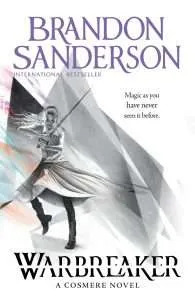 Warbreaker is a pretty wonderful fantasy tale that works as a standalone. It features two princesses, a mysterious and powerful warrior who has a sentient sword, and the politics of the gods of Hallandren; including the marriage of the immensely powerful God King. The God King and other Returned and Awakeners have access to BioChromatic magic.
Warbreaker is a pretty wonderful fantasy tale that works as a standalone. It features two princesses, a mysterious and powerful warrior who has a sentient sword, and the politics of the gods of Hallandren; including the marriage of the immensely powerful God King. The God King and other Returned and Awakeners have access to BioChromatic magic.
“Your way would have involved making several more corpses. Well, I am a sword, Nightblood said with a mental huff. Might as well stick to what you’re good at.…”
The magic system in Warbreaker is intriguing. Utilising the essence of Breath, magic users can access the colours within common objects. This allows some items to be Awakened and used in varied and interesting ways. There are different levels of Heightening, which means the higher the amount of Breath someone has, the more impressive and complex the powers they wield can be. Breath can be given to objects, other people, or lost. The more Breath someone has, the increased attunement they have to their environment, the vividness of colours, and the presence of others. Lacking any Breath, a character’s world would be low definition, indistinct, and with less feeling. Sanderson introduces and enhances this magic system well as the story progresses.
Warbreaker works as a self-contained fantasy story and the main characters are fleshed out and deep. My favourite character to follow is the god Lightsong. He is recognised as being the god of bravery, however, throughout much of Warbreaker, he comes across as a light-hearted and likeable joker. He is one of the Returned and, accordingly, he has priests and followers who revere him and ask him to critique their poetry and artworks. Lightsong’s interactions with his priest ‘Scoot’ and the goddess Blushweaver are always a joy to read. Another standout creation is Vasher. He is complex and formidable, with motives that seem unclear to the degree that I was uncertain whether he was a villain, hero, or something in between. The princesses Vivenna and Siri have very different but similarly engaging journeys. Siri’s is set mostly within the politics of court and Vivenna’s involves rubbing shoulders with hardened mercenaries whose goals may not be just.
“I swear, my dear. Sometimes our conversations remind me of a broken sword.” She raised an eyebrow. “Sharp as hell,” Lightsong said, “but lacking a point.”
The world-building in Wabreaker, though of high quality, does not feel like the main focus, taking a second place to the excellent story. There are histories about past conflicts and rulers, legacies of gods and the nobility, as well as the already discussed imaginative magic system to enjoy when they are presented. Although this novel is 652 pages, it does not feel that lengthy when traversing through and embracing this fictional world. I kept wanting to read, glued to the pages, waiting to see what would happen next. Furthermore, I feel as if the foundations are well set for additional adventures on Nalthis and would gladly welcome the return.
Warbreaker is gripping, the action races by, the intrigue builds up, and it is anything but predictable. At one point I was sure I had outsmarted Sanderson by preempting a twist that would occur later in the book. I was so wrong in my assumption that it seems slightly embarrassing now. The conclusion of Warbreaker was perfectly executed and had me feeling content. Only at this point did I truly appreciate how invested I had become in the story. Sanderson is a master at creating believable societies in his fiction, intricacies and inventive swear words and all. There is much to enjoy when reading this entry in Sanderson’s Cosmere series and I believe this could work as a rewarding first foray into the author’s work. For me now though, I am moving straight on to Wind and Truth.
Read Warbreaker by Brandon SandersonThe post REVIEW: Warbreaker by Brandon Sanderson appeared first on Grimdark Magazine.
December 10, 2024
REVIEW: Space Punks 3 by Anna Mocikat
Last Updated on December 11, 2024
Space Punks is an indie sci-fi series by Anna Mocikat (author of Behind Blue Eyes) that combines cyberpunk themes with gory action. The latest instalment in the series is Space Punks 3. It forgoes a proper sequel title and that fits with how the books are written. They come off more as serialized fiction than a pure set of sequels, as the stories flow from one to another with precious little breakage between. I don’t have any problem with that, as I love reading stories that way but those who want closure on the major plots may find this frustrating.
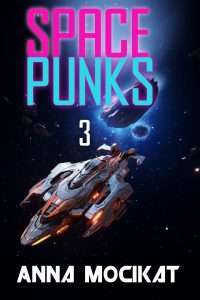 The premise is that the Earth has been destroyed in a war between humanity and the Mimics. The Mimics are machines that possess the ability to assume human shape and slaughtered most of mankind in an uprising that only cybernetic soldiers called the Legion were able to avert. Unfortunately, the Legion is composed of a brutal bunch of sociopaths that have since established themselves as humanity’s oppressive new rulers. The remainder of mankind lives on Mars as well as a handful of extrasolar colonies.
The premise is that the Earth has been destroyed in a war between humanity and the Mimics. The Mimics are machines that possess the ability to assume human shape and slaughtered most of mankind in an uprising that only cybernetic soldiers called the Legion were able to avert. Unfortunately, the Legion is composed of a brutal bunch of sociopaths that have since established themselves as humanity’s oppressive new rulers. The remainder of mankind lives on Mars as well as a handful of extrasolar colonies.
A group of misfits, the starship Nephilim’s crew attempts to stay one step ahead of the Legion. The series has shades of Cowboy Bebop and Firefly, though much more punk and sexier. Unfortunately, the events of the previous two books have thoroughly destroyed the Nephilim crew’s ability to lay low and they’ve burned their bridges with a lot of important people.
The chief characters of Space Punks 3 are Aztec and Seraph, a pair of ex-legionnaires who have had a “friends with benefits” relationship for years that recent events have started moving toward true love. Seraph, the bad boy of the pair, is the one who is pushing for a committed relationship while Aztec struggles with the concept since she has almost no frame of reference for monogamy. It’s an interesting dynamic and contrasts against the rest of the crew.
I really like the world-building of the Space Punks world as each chapter opens with facts and factoids about the planet’s history. While not quite Dune in its complexity, Anna Mocikat has clearly put a great deal of thought into how the universe functions as well as what people believe. While the Mimics are an excellent threat, humanized and alien simultaneously, I have to say the most grimdark element of the book is Lucien.
Lucien is an extremely repulsive sexual predator who has absolute authority over all his subordinates. One terrifying scene has him take a woman who offended him, put an explosive chip in her brain, and turn her into a sex slave. The scene illustrates the kind of graphic darkness that Anna Mocikat is willing to include in her books even if it is all from Lucien’s musings. Individuals who don’t want to deal with this sort of thing should be warned.
In conclusion, Space Punks 3 is a fantastic installment of the series, but you’ll probably be lost if you haven’t read the previous two. Even if you have read them, it might be a good idea to give them a once over to make sure you know everyone’s place in the storyline. It’s not exactly Game of Thrones but the character development is deep and often references events that just happened. Still, a solid recommendation.
Read Space Punks 3 by Anna MocikatThe post REVIEW: Space Punks 3 by Anna Mocikat appeared first on Grimdark Magazine.
December 9, 2024
Grimdark Magazine acquires world rights to Novella by Essa Hansen set in The Graven universe
Last Updated on December 10, 2024
In The Graven trilogy, Essa Hansen writes some of the most imaginative, dark, and action-packed sci-fi I’ve ever read. If you enjoyed Nophek Gloss as much as I did, then strap in. In July 2025 Grimdark Magazine will be publishing a science fantasy novella by Hansen set in the universe of The Graven, featuring an all-new set of characters thrown into a barnstorming story!

We asked Essa about why she wanted to return to the universe of her The Graven trilogy:
More news to comeI am very excited that Grimdark Magazine has offered this opportunity to revisit the world of The Graven, taking us to a familiar place but far in the past, with an all new cast. It’ll be a fun, brutal, cinematic, sensory introduction to the bubble multiverse for new readers, and answer some origin story questions for trilogy fans. A wayward culinarian finds himself dropped into a battle royale hunt across the most dangerous planet in the multiverse, through a wilderness of alien ecology like Scavengers Reign, and featuring the creative cooking of Delicious in Dungeon. His specialty is transuniversal physics and how materials transform between pocket universes—a skill that can be as deadly as it is delectable. Look forward to this in July 2025!
Please join our mailing list for more news on Essa’s novella and monthly newsletters providing insights into the world of dark SFF across books, screen, and video games, and other news and updates. You’ll also get a free magazine issue with featuring a short story set in Richard Swan’s The Art of War space opera universe!
ReviewersWant to review this novella? If you’re a reviewer (review websites, Booktubers, Booktokkers, GoodReads, etc) interested in this novella, please fill out our publicity form, here. We will be doing a very limited run of print copies, and will also have ePub copies.
The post Grimdark Magazine acquires world rights to Novella by Essa Hansen set in The Graven universe appeared first on Grimdark Magazine.
December 8, 2024
Eight Cyberpunk Movies to Ruin Your Hope for the Future
Last Updated on December 9, 2024
Cyberpunk reached its heyday in the Eighties and early Nineties according to most fans but for reasons unconventional to science fiction. Basically, cyberpunk became indistinguishable from reality as the trends envisioned by Blade Runner and Neuromancer largely came true. We now live in a near-universally online society where computers are as ubiquitous as the telephone and corporations wield power greater than nation states. Less charitably, we might as believe that society has become an exaggerated parody of itself with whatever example you’re probably thinking of.
However, I’d argue that cyberpunk remains relevant because of this rather than despite it. The mixture of the high-tech miracles of science and the gritty urban sprawl are eternally effective contrasts. The only differences are we have come to accept that there’s no Star Trek utopia coming from science as long as society dictates there should be “haves” and “have not’s.”
While cyberpunk remains a literary work that I support as both author and fan, I also feel like it’s best experienced on the screen as well. So here is a collection of eight recommended cyberpunk films for those who want to experience what the genre is. It is, after all, better lived than explained.
8. Elysium (2013)Elysium is a film that I was back and forth about because there’s so many other good examples of the cyberpunk genre. However, Elysium is squarely upfront about its themes and as basically as pure an example of the genre as you’re going to find. The rich have destroyed the planet with their corruption and moved to a space station called Elysium while continuing to employ the poor as slave labor to sustain their lifestyle. There’s a lot to be said about health care, immigration reform, and labor rights but it’s also got cyborgs beating the crap out of one another.
7. Strange Days (1995)Strange Days is an interesting example of cyberpunk because there’s only one bit of new technology in the world: the ability to record memories. This has resulted in an underground market for pornography and extreme experiences but also has resulted in danger to the police. In a bit of prescience with cell phones, the recorded memories become a tool against corruption as well as boys in blue brutality. The casting in this movie is strange with Ralph Fiennes, Juliette Lewis, and Angela Bassett but I think it’s aged like fine wine in its predictions.
6. Dredd (2012)The Judge Dredd comic has a strange relationship with cyberpunk. It is absolutely an example of a cyberpunk world but struggles due to the fact its hero is an authoritarian. It’s sort of like Warhammer 40K and the fact that not everyone realizes the Imperium isn’t meant to be the good guys. Joe Dredd is as nice as a brutal fascist regime’s enforcer can be but he needs a humanizing element, which Dredd provides. Dredd and Anderson have a ‘drug bust’ gone horribly wrong that illustrates a hellish dystopia made one level at a time. Karl Urban really deserved to make at least three movies of this.
5. Akira (1988)Some may suggest it is blasphemy putting this anime so low on this list while others may question why it’s here at all. Akira is a movie that condenses a massive manga story into something barely comprehensible but blows the mind away with its stunning visuals. Tetsuo is a young biker punk who becomes infected with godlike powers that soon destroys everything human inside him. Kaneda wants to desperately save his friend and doesn’t care about the apocalyptic consequences of Tetsuo’s ascension.
4. The Matrix (1999)It was a difficult choice between this movie and the other Keanu Reeves’ classic, Johnny Mnemonic. Mostly, I ended up choosing The Matrix because it’s a better cyberpunk film. A group of hacker revolutionaries are up against the machines that overthrew humanity before locking us in an eternal MMORPG. The Machines are better treated as metaphor for society’s crushing banality and oppression, but the people of Zion certainly look good opposing them.
3. Ghost in the Shell (1995)Yet another authoritarian protagonist, Major Motoko Kusanagi (which is the equivalent of someone being named “Jane Excalibur”), is a much more ambivalent about the society she lives in. It is always on the verge of collapsing due to how humanity has discovered countless ways to turn cybernetics as well as computers against one another. The themes of isolation and escaping our destinies via merging with others are fascinating even decades later. Oh, and you can see her fight a spider tank.
2. Robocop (1987)One of my favorite cyberpunk movies growing up, Robocop remains a stunning mixture of social satire with glorious over-the-top action. There’s also some genuinely moving moments in the body horror as well as drama. Alex Murphy is turned into a machine by the sinister OCP corporation and set against the sociopathic Boddicker in a tale of good versus evil that makes it clear society always leans to the latter. Like Blade Runner, the fact its protagonist is a cop is an illustration of how bad the system is rather than an endorsement of it. No one, after all, betrays Murphy worse than the people he works for.
1. Blade Runner: The Director’s Cut (1982)There was probably no doubt this movie was going to be number one cyberpunk recommendation. Ironically, I almost chose its sequel for the top spot as it proceeds to go one step further with its themes. Still, Harrison Ford’s Rick Decker is a character that is blackmailed back into a job that he hates to hunt people that just want to live (but will kill to do so). No one is good and the world is slowly dying in the original noir detective/cyberpunk mashup.
Honorable Mentions: Total Recall (1990), Minority Report, Sneakers, Hackers, Johnny Mnemonic, Alien: Romulus, Running Man, Inception
The post Eight Cyberpunk Movies to Ruin Your Hope for the Future appeared first on Grimdark Magazine.
December 7, 2024
REVIEW: The Company of the Wolf by David Wragg
If you thought The Hunters was a thrilling and tragically funny dark fantasy romp, then you are not ready for the astonishing feat of storytelling madness that David Wragg has in store in The Company of the Wolf. In this exhilarating second instalment in the Tales of the Plains series, the dynamic duo of Ree and Javani are back and better than ever for a new unexpected adventure full of unlikely allies, hysterical witty banter, complex schemes, brutal emotional gut punches, and the most compelling morally grey misfits whose journeys will have you howling with both laughter and deep sorrow by the end.
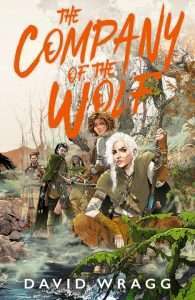 Compared to its predecessor, The Company of the Wolf has a much smaller scope and features a lot less hectic action, but don’t mistake that for me saying that there’s a lack of tension or stakes of any kind. After all the mad dashes and crazy chases across the plains, Javani and Ree have travelled into the mountains to seek a better and more quiet life, but through a series of unfortunate events they find themselves having to seek refuge in a remote pacifist village of peaceful nomads. Which, yes, technically sounds like a dream come true for them, if only it wasn’t for the vengeful company of mercenaries threatening the peace; the same band of mercenaries that they may or may not have pissed off on the way there, oops.
Compared to its predecessor, The Company of the Wolf has a much smaller scope and features a lot less hectic action, but don’t mistake that for me saying that there’s a lack of tension or stakes of any kind. After all the mad dashes and crazy chases across the plains, Javani and Ree have travelled into the mountains to seek a better and more quiet life, but through a series of unfortunate events they find themselves having to seek refuge in a remote pacifist village of peaceful nomads. Which, yes, technically sounds like a dream come true for them, if only it wasn’t for the vengeful company of mercenaries threatening the peace; the same band of mercenaries that they may or may not have pissed off on the way there, oops.
To me, Wragg’s exceptionally strong character work and compelling character dynamics are easily my favourite elements of this series, and I loved how the slower pacing and more vulnerably intimate storytelling allowed those aspects to shine in The Company of the Wolf. The realistically messy development of Ree and Javani, both as individuals and as the most complicated mother/daughter pair, really tugged on my heartstrings and somehow made me love them even more than I already did. Their inner conflicts were depicted in such a beautifully authentic way, be it Ree’s frustration over losing her sense of identity because of her aging, ailing body and her struggles to be a good parental figure, or Javani’s trials and tribulations as she enters into adolescence and starts to fight to stand on her own two legs.
Though, as much as I enjoyed the almost slice-of-life vibe of the first half of The Company of the Wolf, I think the second half is where everything really clicks into place and the true gold is to be found. When Javani and Ree find themselves (accidentally and reluctantly) becoming embroiled in the politics of the village, we get to see some new unexpected relationships blossom as the heart-wrenching secrets and hidden depths of the villagers are slowly brought to light. I can’t deny that it took me a while to accept the fact that we weren’t going to see any of my favourite side characters from book 1 (you know, the ones that made it out alive), but somehow Wragg managed to get me fully invested in this brand-new vibrant cast of characters without me even realising it.
All the most loveable, hateable and intriguingly enigmatic characters just leap off the page with personality, and seeing how the villagers of Ar Ramas reacted to Ree and Javani’s disruptive presence in their deceptively peaceful lives both frustrated and amused me to no end. See, Ree might not be allowed to take her trusty weapons into the peaceful village, but that doesn’t stop her from wielding her sharp tongue as a weapon (which arguably makes her even more menacing and dangerous). For me, the most entertaining scenes were those featuring the grumpy and emotionally scarred hermit hunter Anri who becomes Javani’s new obsession, the power couple Mariam and Vida, and the delicious cherry on top of this sublime sundae for me: Captain Inaï Manatas (or Captain Longwinded, if you’d ask Ree).
I’ll admit that I wasn’t immediately sold on the idea of an additional POV that took away pagetime from my beloved Ree and Javani, but Manatas maybe ended up having my favourite storyline in the end. Not only were his ‘done with everyone’s shit’ attitude and his overly verbose way of speaking entirely too amusing, but I just loved getting a peek into the twisted minds of the exquisitely hateable adversaries (Lado of Cstethia, please choke on a brick of Lego) through his perspective. His unexpected and excitingly forbidden bond with Ree was an absolute highlight of this story for me, and his arc ended up surprising me in all the best ways.
In a way, Wragg’s nuanced exploration of all shades of grey morality and his satirisation of the concept of violence in The Company of the Wolf reminded me of how Abercrombie did a similar thing with heroism in The Heroes, except here we have a lot less bloody battles. While Wragg probably shows a bit more faith in the good of humanity than Abercrombie, he absolutely isn’t afraid to go down some dark paths and deliver some brutal emotional gut punches. The slow-burn build-up to the big action-packed climax at the end of the story resulted in so much satisfying emotional pay-off, which combined with the dark humour is exactly what makes The Company of the Wolf stand out from the generally depressing grimdark crowd for me.
The Company of the Wolf was certainly not the sequel I was expecting, but it turned out to be exactly the sequel that my heart needed and wanted. Especially fans of Joe Abercrombie, Jay Kristoff, and Sebastien de Castell will find much to love here, though I dare say that Wragg’s whip-smart storytelling is even more compelling and morbidly entertaining than those three kings of snark and sarcasm at their best. If you are a fan of dark fantasy with low-magic and high stakes, humour and heart, then the Tales of the Plains is an absolute must read (or listen, because Sara Powell’s narration is simply phenomenal); I couldn’t recommend this highly enough.
Thank you to Harper Collins UK for providing me with an eARC in exchange for an honest review. All opinions are my own.
The post REVIEW: The Company of the Wolf by David Wragg appeared first on Grimdark Magazine.
December 6, 2024
REVIEW: Nosferatu (2024)
Based on Bram Stoker’s Dracula and the silent cinema horror classic of the same name from 1922, Nosferatu is Robert Eggers’ passion project that aims to create a modern horror classic based on the chilling vampire and gothic legend. Eggers brings his own unique style that fans of The Lighthouse, The Witch, and Northman will recognise and he soaks it in gothic dread as a brilliant cast bring the old story to life.
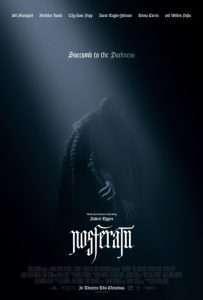 Nosferatu feels like a horror throwback. From the very opening scene that portrays the link between Lily-Rose Depp’s Ellen Hunter and Bill Skarsgard’s Count Orlok, the film brings the fear and informs the audience that it will not be pulling any punches. This is a vampire tale with teeth fully bared and a world away from cool or sparkling vampires modern audiences may be used to. This vampire is a true monster – one to be feared not just with the well-designed jump scares but there is a slow-building tense sense of dread that fills the film and never seems to relent. Every scene with the unrecognisable Skarsgard as Count Orlok has you on the edge of your seat as the music builds and his rumbling voice courses through your body forcing your heart to race. Everything in the film is designed towards create a pure horror film and display a monster worthy to be feared.
Nosferatu feels like a horror throwback. From the very opening scene that portrays the link between Lily-Rose Depp’s Ellen Hunter and Bill Skarsgard’s Count Orlok, the film brings the fear and informs the audience that it will not be pulling any punches. This is a vampire tale with teeth fully bared and a world away from cool or sparkling vampires modern audiences may be used to. This vampire is a true monster – one to be feared not just with the well-designed jump scares but there is a slow-building tense sense of dread that fills the film and never seems to relent. Every scene with the unrecognisable Skarsgard as Count Orlok has you on the edge of your seat as the music builds and his rumbling voice courses through your body forcing your heart to race. Everything in the film is designed towards create a pure horror film and display a monster worthy to be feared.
Fans of Dracula or the original Nosferatu will know the story. Ellen Hunter suffers from seizures and speaks of a dark being who is on his way. Her new husband Thomas, played by the always brilliant Nicholas Hoult (Mad Max: Fury Road), travels across Europe to close a deal with an old, noble Count wishing to purchase property in the newlyweds’ hometown. The locals speak of Orlok as a demon and fear his castle and soon, Thomas is hallucinating and fears that Orlok is after his wife. With Ellen having more of her fits, Willem Dafoe’s Professor Albin Eberhart von Franz steps in as a man with knowledge of the occult as he works with a doctor and Ellen’s friends to prevent Orlok’s path of destruction as he brings a plague with him (along with thousands of rats and a ship of the dead (Voyage of the Demeter is a great full length version of this…). Orlok is a terrific villain. There are nods to the classic German film with Eggers’ usual stunning direction and sense of light at play with the vampire’s shadows playing an important part in the power of the monster. Lily-Rose Depp is also stunning in the film with her understanding of Count Orlok and the shame of her past weighing heavily on her throughout Nosferatu. This truly is a grimdark horror with barely any scenes filled with joy other than those where you just know things are about to be turned on their head.
Eggers has spent almost a decade getting Nosferatu to the big screen and it is a true passion project for the talented director. It really does shy away from modernising the tale and instead embraces its gothic design with its 1800s setting and language suited to the time. The cast give their all to pull it off and their passion and dedication to the film keeps the audience invested throughout the darkness that permeates its whole runtime. This a vampire story where the vampire is a monster that embodies both death and sexuality without it ever feeling cheap or forced.
Nosferatu is a reminder of what true horror can really deliver. It is a film that is dark, beautifully shot, full of great actors on the top of their game, and so unlike anything that has been made in recent memory. Nosferatu reminds us why we do not want to invite such monsters in and this is Eggers’ best work yet.
Watch the Nosferatu TrailerThe post REVIEW: Nosferatu (2024) appeared first on Grimdark Magazine.
December 5, 2024
REVIEW: The City in Glass by Nghi Vo
The City in Glass can only be described as a literary fantasy; an ode to grief, recovery and the healing of time.
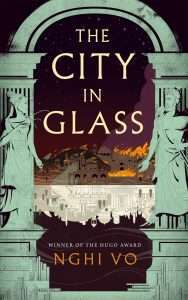 We follow the immortal demon Vitrine, who has adopted the city of Azril, mothering it into something of her very own. That is, until a swathe of angels descend upon her beloved city, bringing with them destruction and devastation as Azril is razed to the ground, along with everything else Vitrine has come to love. Left with nothing but charred remains and demolished buildings, Vitrine is alone with only her memories, and a book kept inside her being that contains the names and stories of all those who once lived in Azril.
We follow the immortal demon Vitrine, who has adopted the city of Azril, mothering it into something of her very own. That is, until a swathe of angels descend upon her beloved city, bringing with them destruction and devastation as Azril is razed to the ground, along with everything else Vitrine has come to love. Left with nothing but charred remains and demolished buildings, Vitrine is alone with only her memories, and a book kept inside her being that contains the names and stories of all those who once lived in Azril.
In a fit of rage, Vitrine curses one of the angels, which then leaves him tethered to her for eternity, or until she decides otherwise. Together, both begrudgingly and with an overwhelming fascination for one another, both angel and demon set out to rebuild Azril, and to wade through the history whispered through the bones of a lost city. When war threatens Azril once more, Vitrine and her angel must decide if they are willing to save their city once again.
Nghi Vo is an expert crafter of worlds and atmosphere, both of which are evident in this novella. She has crafted the story so that the city of Azril is more of a character than it is a setting; wrapping the entire core of the story around one central location breathes life into the novella in such a refreshing manner, and one that is seldom executed so well.
The City in Glass blurs the line of what is typically construed as good and bad. We see angels bringing down destruction and a demon mending what is left behind. I would have liked to learn more about the motivations behind the angels’ actions, but I guess this sort of mystery adds to the violence as a whole. To bring down an entire city, and it’s inhabitants within it, is not an easy feat – so why does it seem so with these antagonists? I find that the grimdark aspect is potent mostly at the time of the angels’ destruction, and the later explorations of grimdark-esque themes are quite watered down and skimmed across. Still, I would recommend this almost-abstract branch of grimdark to even the most grim-hardened reader, as well as someone who is simply looking to dabble in the genre, for a refreshing change.
Read The City in Glass by Nghi VoThe post REVIEW: The City in Glass by Nghi Vo appeared first on Grimdark Magazine.
December 3, 2024
REVIEW: The Savage Sword of Conan #5
While previous issues have included at least one entry spotlighting a different Robert E. Howard character, the fifth issue of Titan Comics’ bimonthly magazine The Savage Sword of Conan delivers three stories exclusively focusing on Conan at different stages in his life.
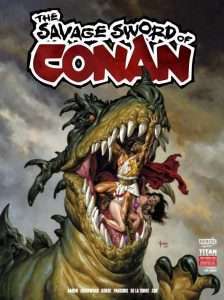 The issue opens with “The Ensorcelled” by Jason Aaron, with art by Geof Isherwood. Bearded King Conan is visiting the chaotic Brythunian borderlands, trying to help the local royalty secure their demesnes, lest their upheaval affect Conan’s neighboring kingdom of Aquilonia. While hunting with the foppish King Fabiano Conan encounters the infamous Witch of Graaskal, blamed for a host of misdeeds including child-murder. While Conan witnesses her powerful sorcery firsthand, he soon grows skeptical of the litany of crimes of which the witch is accused. King Conan intervenes on the witch’s behalf, even though it brings him into conflict with King Fabiano. “The Ensorcelled” features some interesting twists along the way, and Isherwood’s detailed artwork is pleasantly reminiscent of the classic Hal Foster Prince Valiant comics. Frustratingly, however, “The Ensorcelled” is just the first half of a two-part story. At 53 pages in length, “The Ensorcelled” dominates this issue’s 64-page page count, yet readers are still expected to wait two months for a resolution. This reviewer believes strongly that serialized stories are best left to the primary Conan the Barbarian title; The Savage Sword of Conan is at its best when it delivers standalone narratives that can be enjoyed fully by occasional readers of the magazine.
The issue opens with “The Ensorcelled” by Jason Aaron, with art by Geof Isherwood. Bearded King Conan is visiting the chaotic Brythunian borderlands, trying to help the local royalty secure their demesnes, lest their upheaval affect Conan’s neighboring kingdom of Aquilonia. While hunting with the foppish King Fabiano Conan encounters the infamous Witch of Graaskal, blamed for a host of misdeeds including child-murder. While Conan witnesses her powerful sorcery firsthand, he soon grows skeptical of the litany of crimes of which the witch is accused. King Conan intervenes on the witch’s behalf, even though it brings him into conflict with King Fabiano. “The Ensorcelled” features some interesting twists along the way, and Isherwood’s detailed artwork is pleasantly reminiscent of the classic Hal Foster Prince Valiant comics. Frustratingly, however, “The Ensorcelled” is just the first half of a two-part story. At 53 pages in length, “The Ensorcelled” dominates this issue’s 64-page page count, yet readers are still expected to wait two months for a resolution. This reviewer believes strongly that serialized stories are best left to the primary Conan the Barbarian title; The Savage Sword of Conan is at its best when it delivers standalone narratives that can be enjoyed fully by occasional readers of the magazine.
Next is a two-page vignette entitled “Damn Thing in the Water,” by Jim Zub and illustrated by Roberto De La Torre. Conan is set upon by a tentacled beast when stopping for a drink at a watering hole. While De La Torre’s John Buscema-inspired artwork always pleases, the story feels like an abbreviated retelling of Alan Quah’s “Lure of the Pit Creature” from The Savage Sword of Conan issue #3. Overly familiar seeming, perhaps the space for this micro-story could have been better occupied by a Jeffrey Shanks essay or additional full-page pin-up illustrations.
The final story is “Forged,” by Michael Kogge and Dan Parsons. Where “The Ensorcelled” depicts an older Conan, “Forged” presents Conan as a child, apprenticed to his blacksmith father in their Cimmerian village. The story shows young Conan chafing under his father’s strict guidance, but treachery by visiting Zingaran entertainers gives Conan an opportunity to prove himself. My complaint with this story is identical to my criticism of Conan the Barbarian #16: young Conan tales are profoundly uninteresting compared to those featuring the fully-fledged barbarian. Seeing Conan as a boy learning harsh life lessons does not enhance the character’s mystique. Much like a meal, Conan is better with some seasoning. Artist Dan Parsons is also capable of better artwork than what he turned in for this story.
The standard cover for this issue features amazing new Joe Jusko artwork of Conan and a panicked companion struggling to avoid being devoured by a “dragon” (likely some type of dinosaur, in classic Sword & Sorcery tradition). It was disappointing that no such scene appears within this issue. Way back in the first issue, Jim Zub’s editorial gave the impression that the creative team would endeavor to ensure that the cover artwork would reflect the contents of the magazine, and it’s unfortunate that, just five issues in, that loose assurance to the reader no longer holds. (In the interest of fairness, the alternate cover by Alex Horley DOES depict a scene from the opening of “The Ensorcelled.”)
While it’s nice to see a return to original, non-event stories after the Battle of the Black Stone prelude issue, The Savage Sword of Conan #5 doesn’t quite match the standard set by the series’ first three issues. Less devoted Conan fans might be better off waiting to see the reception to issue #6 and the conclusion of “The Ensorcelled” before going out of their way to pick up this issue.
Read The Savage Sword of Conan #5The post REVIEW: The Savage Sword of Conan #5 appeared first on Grimdark Magazine.

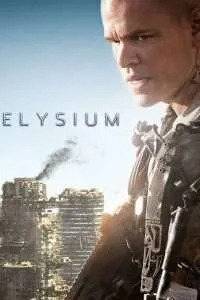 Buy on Amazon
Buy on Amazon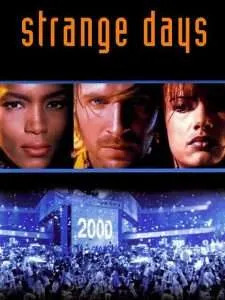 Buy on Amazon
Buy on Amazon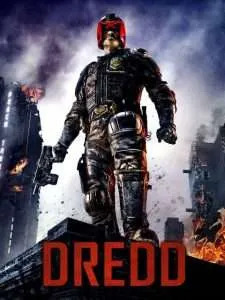 Buy on Amazon
Buy on Amazon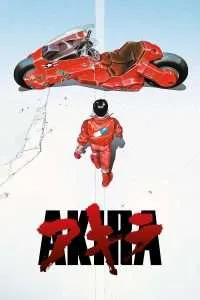 Buy on Amazon
Buy on Amazon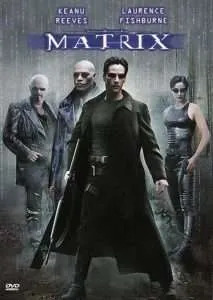 Buy on Amazon
Buy on Amazon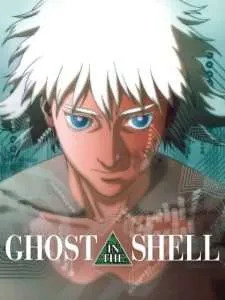 Buy on Amazon
Buy on Amazon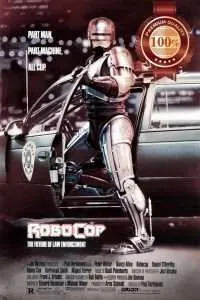 Buy on Amazon
Buy on Amazon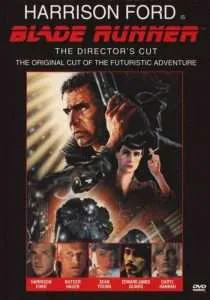 Buy on Amazon
Buy on Amazon

